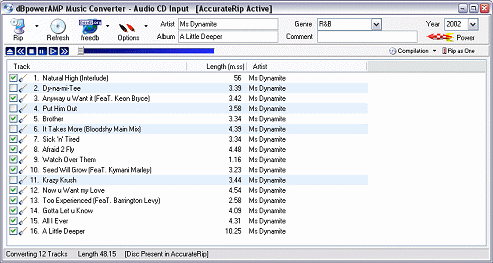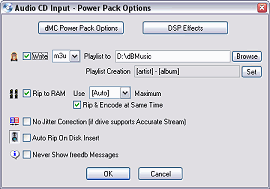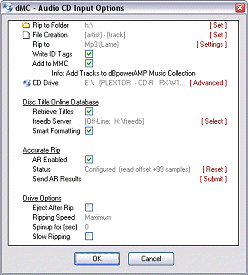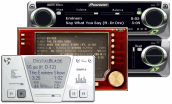Rip (verb): digitally extract audio from an
Audio CD to computer.
dMC Audio CD Input is used to
Rip, found in Start >> Programs
>> dBpowerAMP Music Converter:

Before inserting
an Audio CD, connect to the Internet and the track titles will
be auto-completed from freedb's database upon disc insertion
(privacy watch: no information other than Audio CD
identifier is sent to freedb). If your Audio CD input is stuck on
Insert Audio CD check trouble shooting.
Tracks with Tick Marks will be
ripped upon pressing Rip, a quick way to uncheck all, check all or
to invert the ticks is to right click on one of the tracks and choose said
option from the menu. Whilst looking at this right click menu, there is an
option to Copy Track Listing to Clipboard, a text list of track
names can be pasted into another program. Next to Rip is a menu:

The top two options start the
Ripping process, the only difference being the Rip with Options gives
the choice of verifying the options to be used. Pressing the Rip
button is the same as selecting Rip Audio From CD. Rip To selects the
audio compression format to be used (as well as Install New Codec
to add
WMA, Ogg Vorbis or Mp4). To change the compression settings for the chosen
format click Compression Settings and bitrates, etc can be set.
Each installed Codec tends to have help detailing the Compression settings
available, look in Start >> Programs >> dBpowerAMP Music
Converter >> Help >> Codecs.
|
Power Pack
Additions
Each track has
an Artist entry, this allows dMC to handle compilation
(multi-artist) CDs. The Artist can be entered by selecting one track and
typing into the Artist box at the top. Upon
retrieving freedb details, dMC is smart enough to spot a
multi artist CD and automatically press Compilation
to split out the separate artists. Press Compilation to
manually split or swap the Artist and Track
fields. The menu next to
Compilation allows a track number offset to be specified for
a 2nd disc in a multi disc album.
Preview
Toolbar

The above mini toolbar appears
if the [Power Pack]
is installed, allows for the previewing
of an Audio CD (enhanced keyboard owners with play, skip etc can control
playback from the keyboard).
Rip as One
Sometimes tracks might need to be combined into one big
track, even the whole disc ripped as one audio file, or
parts chopped off an track, Rip as One allows this,
press the button and select the Ripping Start position on
the Red scale with the left mouse button and the Ripping End
position with the right button. Previewing the track might
help determine if the correct start and end positions are
set before ripping. Track Name and Track Number
are used in the ID tag.
Power Button

Starting with
the best option first Rip to RAM and Rip &
Encode at Same Time these two options should be checked
to speed up CD ripping (ripping not compressing), by ripping
in one continuous stream to the computers memory (very
efficient instead of start cd, stop cd, compress, start cd...)
and encode it on a 2nd thread running concurrently.
m3u or pls playlists can be written
for each disk Ripped,
playlists are named based upon Playlist Creation.
No Jitter
Correction can be
used if your CD drive supports accurate positioning (most
modern drives do). Ripping will proceed quicker, although if
Rip to RAM is used there is no point in using this
option.
Auto Rip On
Disk Insert can be used to speed up ripping lots and
lots of discs, Ripping will commence after freedb has been
contacted.
Never Show
freedb Messages can be used to create an unattended
ripping station, any errors pertaining to freedb are not
shown, and should a disc bring back multiple Album choices
the first one is auto-selected, of most use with Auto Rip on
Disk insert.
|

Rip to Folder:
location ripped tracks are stored, combined with File
Creation to determine the final filenames. File
Creation can be set to store audio files in a layout of
your choice - want each album in separate folders? really
easy, just click Set. The audio format used is
specified with Rip To, same as set with Rip
>> Rip To menu earlier. Write ID Tags if
checked stores tracks details, such as Artist and Album
within the audio file (not all audio formats support ID
Tags).
| Now my favorite option (
a designer can be proud :) ), if [dBpowerAMP
Audio Player] is installed Add to MMC can
be ticked, all tracks Ripped will be added straight
into dBpowerAMPs Music Collection and better still,
see the blue highlight lines on Audio CD Input above?
these tracks are highlighted because they already
exist in your Music Collection, saving duplicates from
being ripped. |
 |
Disk Title Online Database
Each time a new CD is inserted dMC will contact the Internet
freedb database to obtain track names, this
automatic action can be switched off by unchecking Retrieve
Titles. Each time titles are retrieved you are reliant
on the person who submitted that information, one group of
people might type a track name as 'the way i am', or
even 'THE WAY I AM', Smart Formatting tries to
correct the previous two to a more palatable 'The Way I Am'.
Setting the freedb server, offline database, auto dialing,
delayed freedb options, or submitting your own additions are
covered in freedb Settings
& Submissions.
Accurate
Rip
A revolutionary way of determining if a CD ripped was
without error (caused by scratches, etc) - each time a CD is
ripped it is compared against CDs ripped by other people
from all over the world. Visit www.accuraterip.com
for details on how to install and configure AccurateRip.
Drive Options
Eject After Rip to auto eject the
CD after ripping, Ripping Speed can be set to slow
down the ripping (the slower the disc spins the less likely
of a Read Error). Some CD drives will not rip correctly
until the drive is spinning at maximum speed, the option Spin
up for (sec) will sort such problems out if they arise.
If you have an old CD drive it might suffer from an
excessive jitter (audible clicking in the audio),
only with such should Slow Ripping be enabled, for
99.999% of modern drives it is not required.
The Option button also has a
small menu:

Copy
Protected Audio CDs
Standard CD Player
Emulation: many 'Copy Protected' audio CDs (I call
them damaged CDs) exploit a weakness of a computer system as
being different to a normal audio CD player. If Table of Contents Detection
is checked then the disc contents are read using sub-codes,
this will almost certainly enable the reading of the correct
track lengths should they appear wrong. All being well such
a disc can be ripped, but it depends mostly on your CD drive,
which needs to be able to rip outside the false first disc
contents table (not all will), if this is the case then take a black marker pen (don't use a permanent pen!)
and draw around the outside
tracks (search the internet for Copy
Protected Audio CD black marker pen, for more details).
Finally a new breed of nasty audio protection has just been
released, the Audio CD contains a nasty program that
installs on your computer (with out permission) and will
take control of your CD drive to block it, in many ways like
a virus might. I recommend that when ANY copy
protected Audio CD is inserted into your computer hold the
LEFT SHIFT key before, during and 10 seconds after
inserting, this stops the nasty program from running.
Remember it is the music company that is treating you like a criminal,
taking away your fair use rights with such measures, complain and they might abandon their silly
ideas.
Audio CD Parameters
allows the track times to be set as well as the starting
time, use this if the above option fails to read the correct
CD track lengths.
Character Replacement
Certain characters cannot be used for
filenames, but they might appear in Artist and Track names which are used to create the filename (File Creation above).
These bad characters can be auto-changed into similar allowed
ones, the default values do a pretty good job.
AccurateRip Results
displays the last results for a Ripped disc, and Submit
AccurateRip Results does just that, submits your ripped
results to the central database. Submissions only need to be
made once every so often, when many many discs have been
ripped.
CD Text - if you have a CD Text
compatible drive and your Audio CDs contain CD text (certain Sony CDs)
then CD Text can be enabled on Options >> Select CD
Drive and Advanced. If using freedb there is no real need
for CD Text.
Q. No audio tracks are
listed?
A. Try Options and make sure the correct CD
Drive is selected. Still no go? for Windows NT / 2000 or XP select Advanced
(next to CD Drive) and change Communications to NT/2000
Built-in (Limited). Other Windows versions see [Audio
CD Input FAQ].
Q. My CD drive does
not Rip at full speed?
A. So you have a 52x Speed CD drive?, yet it seems to take 3 Minutes
to Rip a 3 Minute track...well firstly to test your Ripping speed convert one
track to Test Conversion (if converting to mp3 most of the time will be taken
up compressing!). If the extraction speed is obviously too slow (I have
a 52x speed CD and it rips at 15x for track 1, and 28x for the last
track, this is normal) try this [Audio
CD Input FAQ].
Q. It Rips, but
sometimes there are clicks and jumps?
A. Just as your glasses need a clean, so might your
CD discs, clean with a soft lint free cloth. Finally try reducing your
Ripping Speed in Options.
<<
Quick Start Guide | Main Index
| freedb Settings
& Submissions >>

![]()